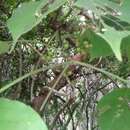Comprehensive Description
provided by North American Flora
Elaphrium occidentale Rose, sp. nov A large tree ; young branches grayish, softly pubescent; leaves pinnate ; leaflets 5-7, broadly ovate to shortly oblong, abruptly or shortly acuminate, 6-8 cm. long, softly pubescent on both surfaces, sometimes quite sessile ; inflorescence a narrow elongate panicle, in fruit sometimes reduced to a simple raceme, softly pubescent ; calyx-lobes pubescent; ovary and fruit pubescent ; drupes globose, 6 mm. in diameter; stone flattened dorsally, faintly 3-angled.
Type collected between Rosario and Concepcion, Sinaloa, July 27, 1897,/. TV. Rose 3259d(V. S. Nat. Herb. no. 302232).
- bibliographic citation
- John Kunkel Small, Lenda Tracy Hanks, Nathaniel Lord Britton. 1907. GERANIALES, GERANIACEAE, OXALIDACEAE, LINACEAE, ERYTHROXYLACEAE. North American flora. vol 25(1). New York Botanical Garden, New York, NY
Comprehensive Description
provided by North American Flora
Elaphrium grandifolium Schlecht. L,innaea 17 : 249. 1845
Bursera grandifoha Engler, in DC. Monog. Phan. 4: 45. 1883. Terebinthus gr'andifolia Rose, Contr. D. S. Nat. Herb. 10 : 119. 1906.
Young branches pubescent ; leaves large for the genus ; leaflets 5, ovate to obovate, shortly acuminate, 5-7 cm. long, entire, glabrous above, pubescent beneath; drupes 12 mm. 'ong, obovoid, somewhat 3-angled, a little pilose.
Type locality : Mexico.
Distribution : Probably eastern Mexico.
- bibliographic citation
- John Kunkel Small, Lenda Tracy Hanks, Nathaniel Lord Britton. 1907. GERANIALES, GERANIACEAE, OXALIDACEAE, LINACEAE, ERYTHROXYLACEAE. North American flora. vol 25(1). New York Botanical Garden, New York, NY
Bursera grandifolia: Brief Summary
provided by wikipedia EN
Bursera grandifolia is a Mexican species of trees in the frankincense family in the soapwood order. It is widespread across much of Mexico from Sonora to the Yucatán Peninsula, and found also in Central America as far south as Costa Rica.
Bursera grandifolia has leaves that are pinnately compound with 5 leaflets, each leaflet egg-shaped and 5–7 cm long, hairy on the underside but not on the topside. Drupes are egg-shaped with a few scattered hairs.
- license
- cc-by-sa-3.0
- copyright
- Wikipedia authors and editors

